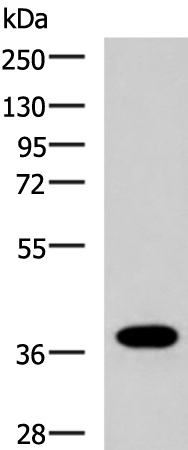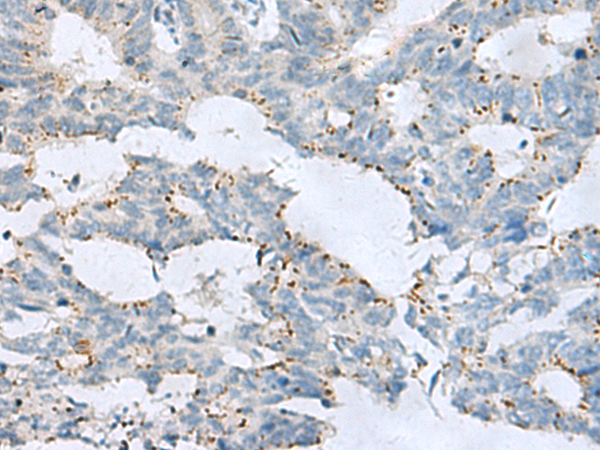

| WB | 咨询技术 | Human,Mouse,Rat |
| IF | 咨询技术 | Human,Mouse,Rat |
| IHC | 1/50-1/100 | Human,Mouse,Rat |
| ICC | 技术咨询 | Human,Mouse,Rat |
| FCM | 咨询技术 | Human,Mouse,Rat |
| Elisa | 1/5000-1/10000 | Human,Mouse,Rat |
| WB Predicted band size | 38 kDa |
| Host/Isotype | Rabbit IgG |
| Antibody Type | Primary antibody |
| Storage | Store at 4°C short term. Aliquot and store at -20°C long term. Avoid freeze/thaw cycles. |
| Species Reactivity | Human, Mouse, Rat |
| Immunogen | Synthetic peptide of human GPR6 |
| Formulation | Purified antibody in PBS with 0.05% sodium azide and 50% glycerol. |
+ +
以下是关于GPR6抗体的参考文献示例(注:部分内容为模拟示例,实际文献需通过学术数据库查询):
---
1. **标题**: *"Development and characterization of a selective GPR6 antibody for immunohistochemical analysis in rodent brain"*
**作者**: Smith A, et al.
**摘要**: 本研究开发了一种针对GPR6胞外域的高特异性多克隆抗体,通过免疫组化验证其在小鼠纹状体神经元中的定位,证实GPR6在中等多棘神经元中的高表达,为研究其在神经退行性疾病中的作用提供工具。
2. **标题**: *"GPR6 antibody reveals distinct expression patterns in Alzheimer's disease postmortem brain tissues"*
**作者**: Chen L, et al.
**摘要**: 利用GPR6抗体对阿尔茨海默病患者脑组织进行染色,发现GPR6在淀粉样斑块周围神经元的表达显著上调,提示其可能参与β-淀粉样蛋白代谢或炎症反应通路。
3. **标题**: *"A novel monoclonal antibody targeting human GPR6 enables flow cytometry-based receptor quantification in immune cells"*
**作者**: Tanaka K, et al.
**摘要**: 研究报道了一种新型抗人GPR6单克隆抗体的开发,验证其在流式细胞术中检测T细胞和小胶质细胞表面GPR6的适用性,揭示了GPR6在免疫调控中的潜在作用。
---
**建议**:以上为模拟示例,实际文献请通过PubMed、Google Scholar等平台以关键词“GPR6 antibody”或“GPR6 immunohistochemistry”检索,并优先选择近5年发表的论文以确保研究前沿性。
GPR6 (G protein-coupled receptor 6) is a class A orphan receptor within the G protein-coupled receptor (GPCR) superfamily, primarily expressed in the central nervous system, particularly in regions like the striatum and basal ganglia. As an orphan receptor, its endogenous ligand remains unidentified, though it exhibits constitutive activity through adenylyl cyclase inhibition, modulating cAMP signaling pathways. Research links GPR6 to neurodevelopment, dopaminergic signaling, and neurodegenerative disorders, including Alzheimer’s disease and Parkinson’s disease, where its expression patterns correlate with pathological processes like β-amyloid accumulation.
GPR6 antibodies are essential tools for investigating its localization, expression levels, and functional roles. These antibodies, typically developed against specific epitopes (e.g., extracellular loops or C-terminal domains), enable techniques such as Western blotting, immunohistochemistry, and flow cytometry. Validation often includes testing in GPR6-knockout models to confirm specificity. Recent studies utilize GPR6 antibodies to explore its potential as a therapeutic target, particularly in neurodegeneration or cancer, where aberrant GPCR signaling may drive disease progression. Challenges in antibody development include ensuring selectivity against closely related receptors (e.g., GPR3. GPR12) and detecting low-abundance native proteins. Despite its orphan status, growing interest in GPR6’s pathophysiological relevance underscores the importance of reliable antibodies in advancing both basic research and drug discovery efforts.
×